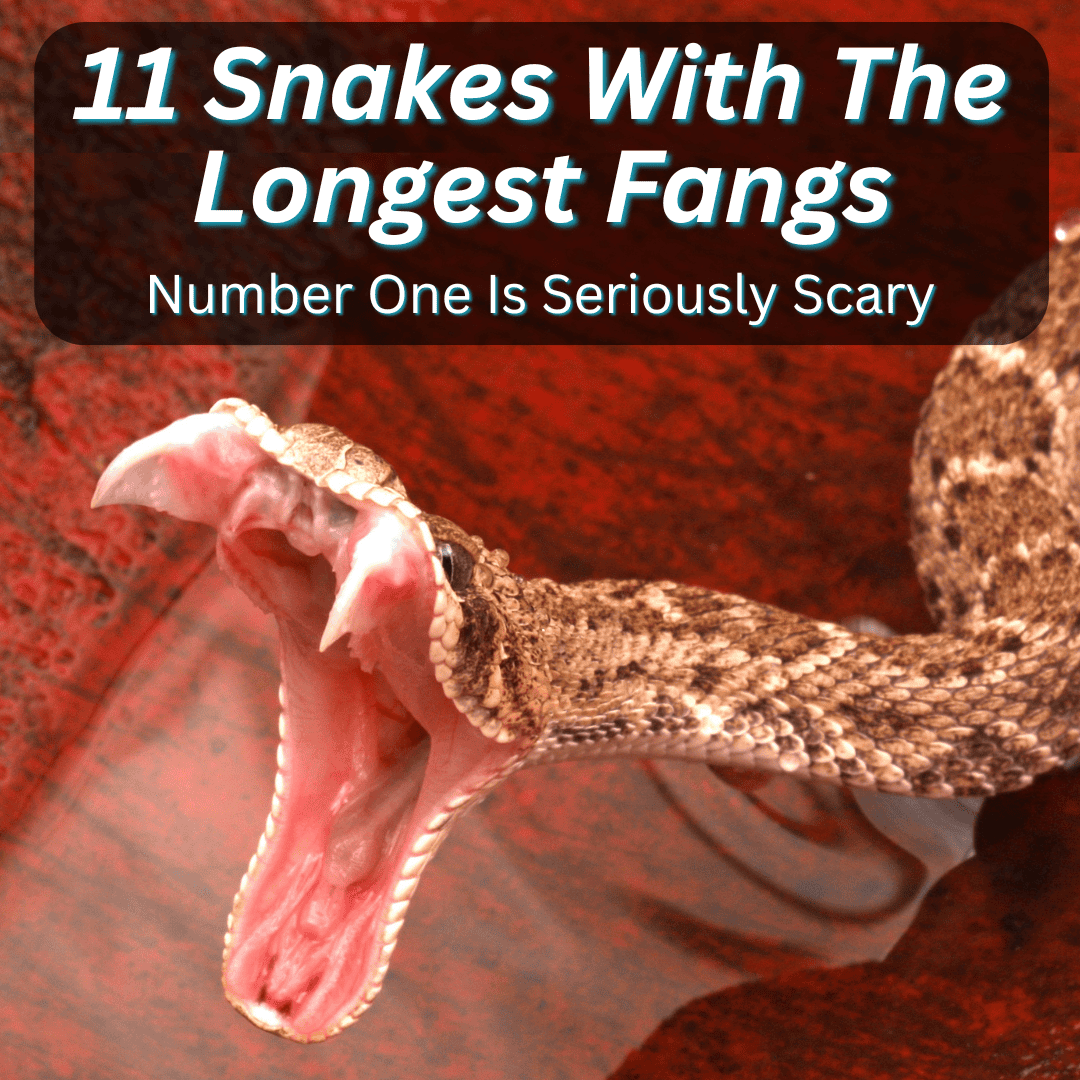
These sharp, hollow teeth let venomous snakes hunt and defend themselves in the wild.
But most snakes don’t even have fangs.
Out of over 4,000 snake species in the world, only about 600 are venomous and have fangs designed to deliver poison.
Fang length often matches the snake’s size and hunting style.
Some snakes have developed fangs that can reach up to 2 inches in length.
These natural weapons, paired with powerful venom, turn certain snakes into top predators—whether they’re massive vipers in African forests or quick-striking rattlesnakes in American deserts.
Snakes With The Longest Fangs
Let’s meet the 11 snakes that boast the longest fangs. We could have also titled this article “snakes that make the worst pets for beginners.”
1. Gaboon Viper
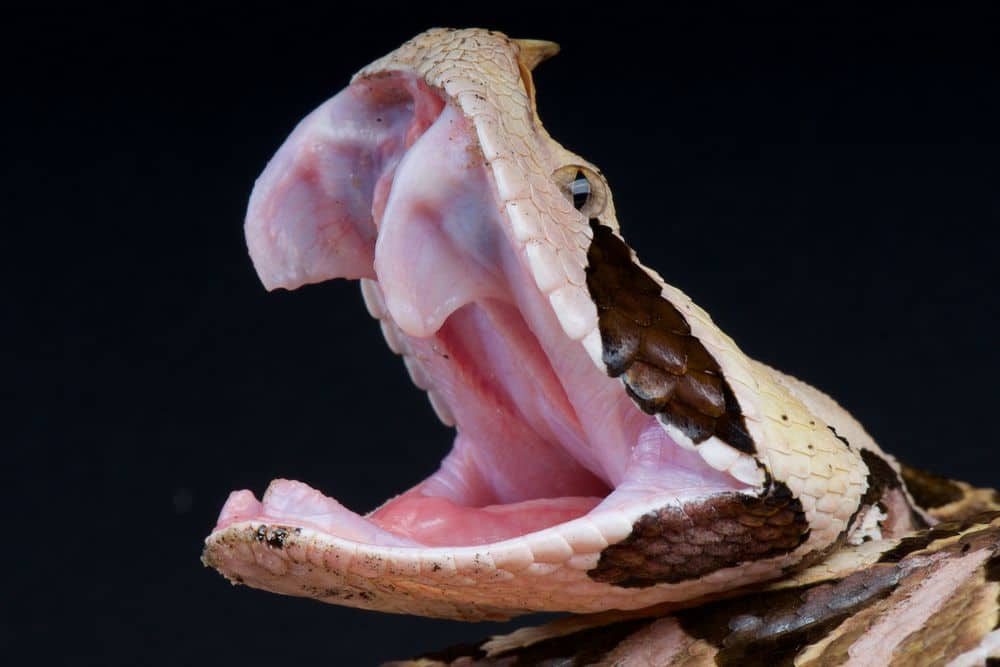
The Gaboon viper holds the record for the longest fangs of any venomous snake. Their fangs can reach up to 5 centimeters, or about 2 inches.
You’ll find these huge vipers in the rainforests and savannas of sub-Saharan Africa. They’re the largest members of the Bitis genus.
These fangs fold back when not in use, then swing forward when the viper strikes to deliver venom deep into prey.
The Gaboon viper’s fangs work with one of the highest venom yields of any snake. This species can deliver more venom in a single bite than any other snake species: between 200 and 1000 milligrams. Their wide heads house large venom glands, supporting these massive fangs.
The fangs can take down prey as large as antelopes. Surprisingly, these snakes use their record-breaking fangs mainly for hunting, not defense—they’d rather rely on camouflage to avoid trouble.
Their venom contains both hemotoxins and neurotoxins, affecting blood and nervous systems alike. A Gaboon viper bite is a serious emergency. The massive venom dose can cause rapid swelling, intense pain, and can be fatal without fast treatment.
2. Bushmaster
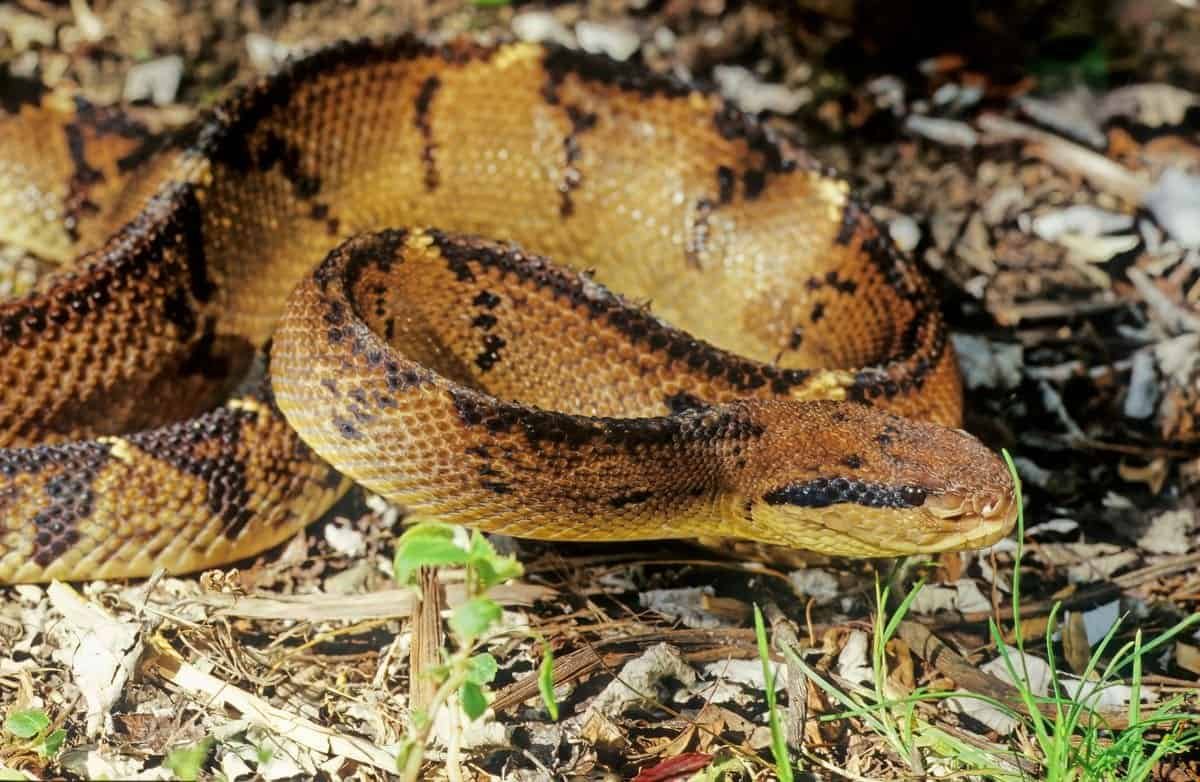
The bushmaster is the longest venomous snake in the Americas. You’ll find this pit viper in forests from Costa Rica down into the Amazon basin.
Its fangs can reach up to 1.5 inches. These hollow, retractable fangs are ideal for its hunting style. When the bushmaster strikes, those long fangs penetrate deep, injecting venom far into the victim’s tissue. The deep injection makes venom more effective. The venom reaches vital areas quickly, making the bite especially dangerous.
Bushmasters use a sit-and-wait strategy, holding perfectly still until prey comes close, then striking with lightning speed. They truly are snakes that are masters of ambush hunting.
Their fangs help them grasp prey too. Once they bite, the long fangs help hold onto struggling prey while venom does its work. The bushmaster’s fang length gives it a real edge over shorter-fanged snakes in jungle environments.
3. Eastern Diamondback Rattlesnake
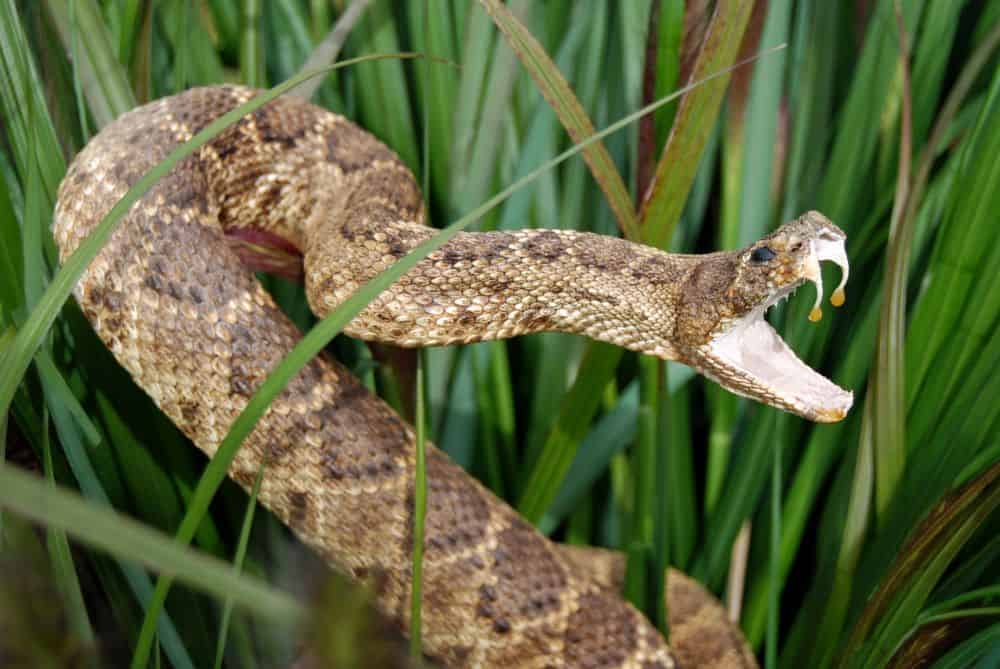
The eastern diamondback rattlesnake has some of the most impressive fangs in North America. These curved, hollow fangs can grow up to one inch long in big snakes.
The fangs connect directly to venom glands and fold back into the mouth when not in use. The eastern diamondback has the longest fangs of any rattlesnake species relative to its length.
A five-foot snake might have fangs about two-thirds of an inch. That’s pretty big for a snake that size.
These fangs act like hollow needles. When the snake strikes, venom flows through the fangs and into the victim. The curved shape helps them penetrate deeply.
The eastern diamondback is already the largest rattlesnake in the world, and those long fangs let it deliver a lot of venom quickly.
4. Reticulated Python
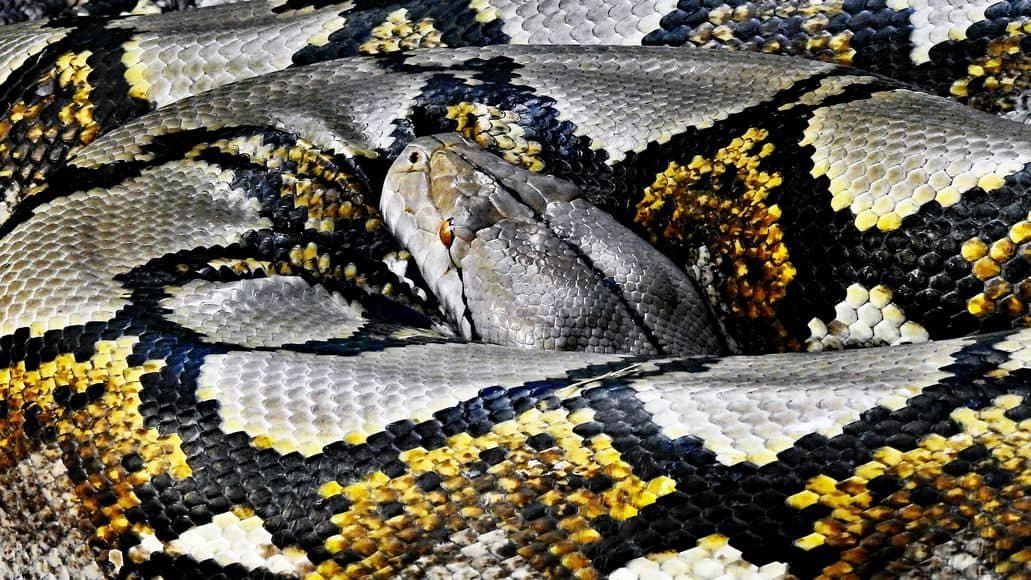
You’ll find the reticulated python in Southeast Asia. It is the world’s longest snake. Some reach over 30 feet and weigh up to 350 pounds.
Its name comes from the net-like pattern on its scales—a beautiful design that covers their massive bodies.
Unlike venomous snakes with front fangs, reticulated pythons have small, sharp rear fangs. These backward-curving teeth grip prey during feeding.
They don’t rely on venom to kill. Instead, they use their powerful bodies to squeeze prey in a process called constriction. Their rear fangs act like tiny hooks, pointing back toward the throat to keep prey from escaping.
Even though these fangs are much smaller than the front fangs of venomous snakes, the massive size of the reticulated python means that even these “smaller” rear teeth are actually larger than most snakes’ “larger” front fangs. They can measure up to one inch in length.
These pythons are strong swimmers and can travel far from shore. You might even spot them on small islands in their range.
The combination of sharp rear fangs and incredible size makes reticulated pythons formidable predators. They can take down deer, pigs, and even small primates in their native habitat.
5. Rhinoceros Viper
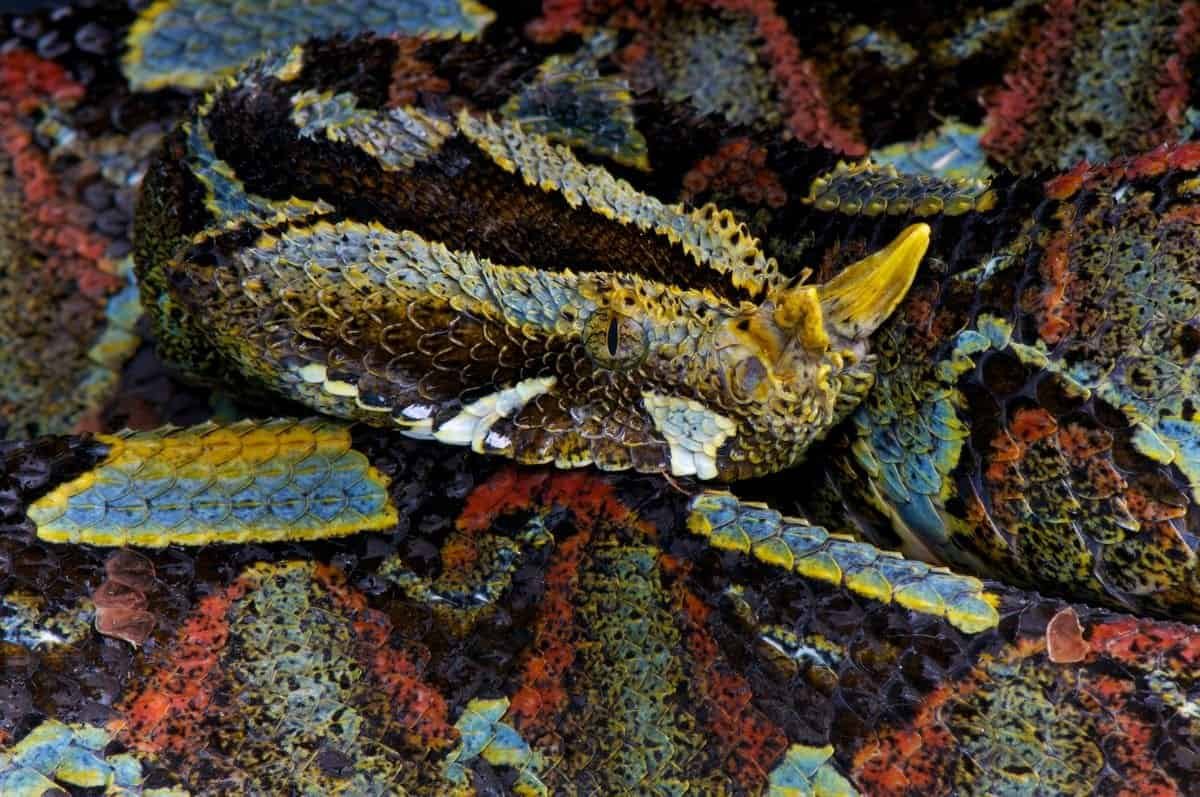
The rhinoceros viper, also known as the river jack, is one of Africa’s most visually stunning snakes. Its vibrant blue, green, and yellow scales, along with the horn-like projections on its snout, make it instantly recognizable in the rainforests and swamps of West and Central Africa.
This viper’s fangs can reach up to 2.5 centimeters (about 1 inch) in length. Like other members of the viper family, the rhinoceros viper’s solenoglyphous fangs fold back when not in use and swing forward in an instant for a deep, precise strike.
The rhinoceros viper is an ambush predator, relying on its camouflage and patience to catch unsuspecting prey. When it strikes, its long, hollow fangs inject a powerful mix of hemotoxins and neurotoxins, quickly immobilizing rodents, amphibians, and birds.
Though its venom is potent, the rhinoceros viper is generally slow-moving and non-aggressive, preferring to rely on its camouflage rather than confrontation. Bites to humans are rare but can be very serious, causing pain, swelling, and tissue damage.
With its combination of bold coloration, horned snout, and impressive fangs, the rhinoceros viper is a true marvel of the African forests—beautiful to behold, but best admired from a safe distance.
6. Fer-de-Lance
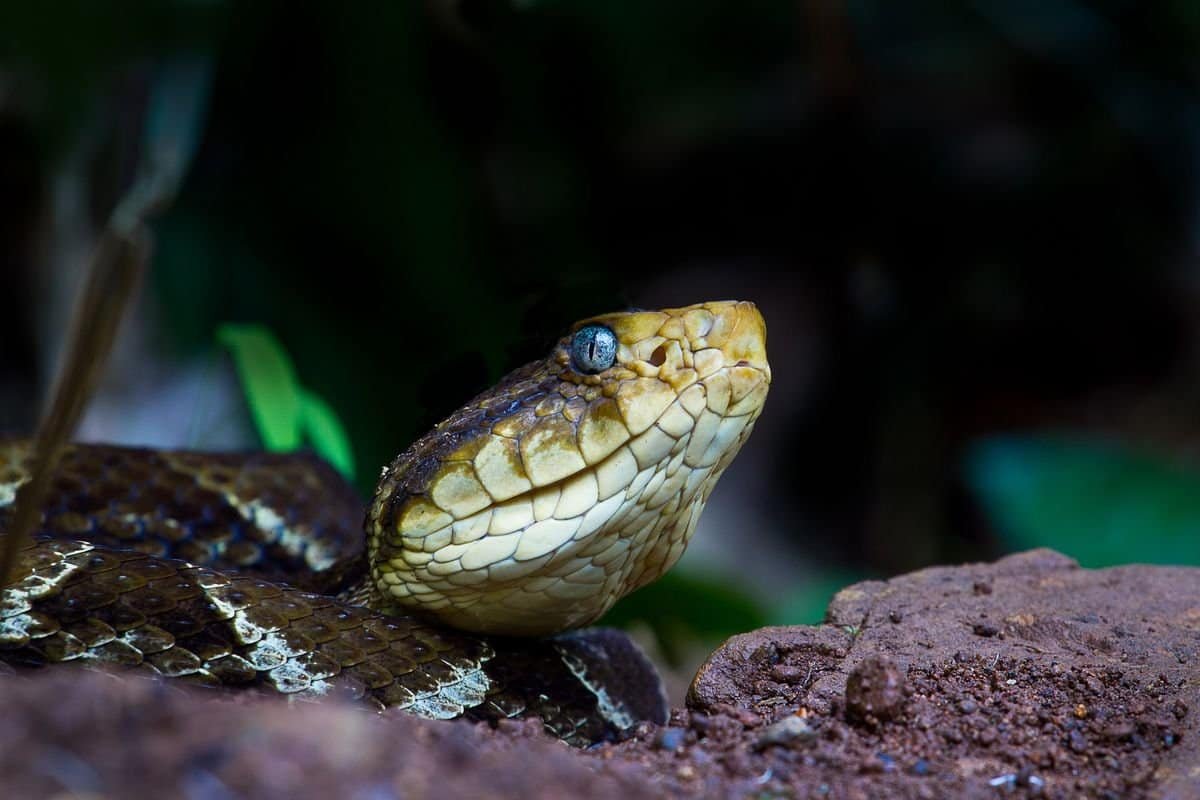
The fer-de-lance has some of the longest fangs relative to their body size that you’ll see on any snake. They can be over 1 inch long. These hollow fangs sit in the front of its mouth and fold back when not needed.
When this snake gets ready to strike, it forms an S-shape with its head and body. From this position, it attacks so fast that you might not even see it move.
The long fangs act like needles, injecting venom deep into prey. Because they’re hollow, they can deliver a lot of venom quickly.
Fer-de-lance snakes don’t hesitate when threatened. Unlike other large vipers that prefer to escape, these snakes are much more likely to strike first.
Their fangs extend instantly when they bite, then retract just as quickly. This allows for a “strike and retreat” attack style.
Long fangs and fast striking make the fer-de-lance especially dangerous. These snakes can reach up to six feet, giving them serious striking power and reach.
7. Puff Adder
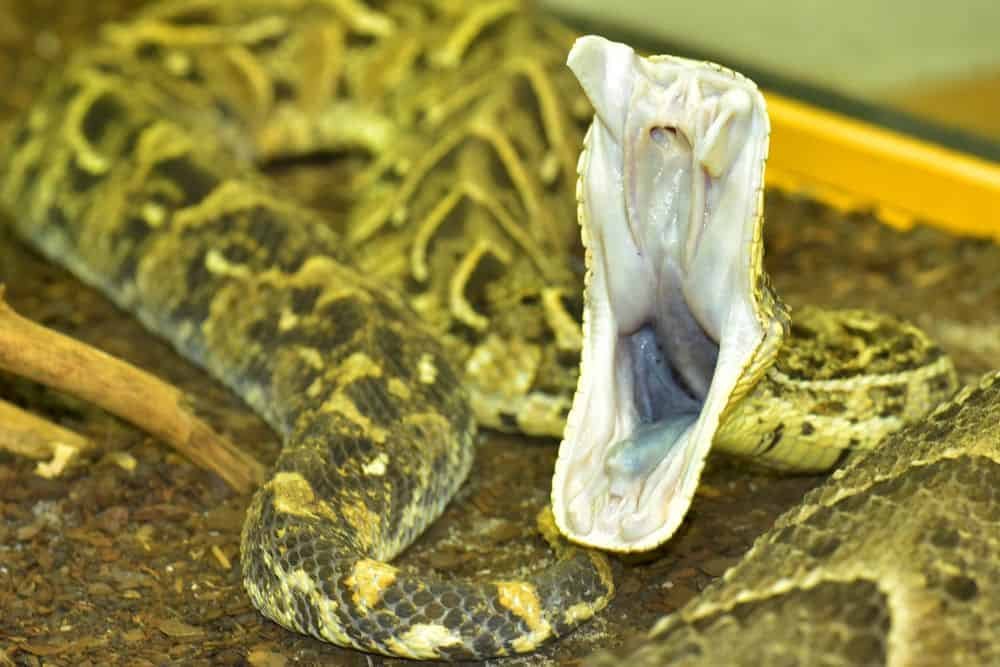
The puff adder is one of Africa’s most widespread and dangerous snakes, found in grasslands, savannas, and even farmlands across the continent.
This hefty viper boasts impressive fangs that can grow up to 1.5 centimeters (about 0.6 inches) long. Like other vipers, the puff adder’s fangs are solenoglyphous—they fold back against the roof of the mouth when not in use and swing forward during a strike.
The puff adder’s fangs are perfectly suited for its ambush hunting style. The snake relies on camouflage and patience, lying still until prey gets close. When it strikes, those long, hollow fangs punch deep into the victim, delivering a potent dose of cytotoxic venom.
This venom destroys tissue and blood cells, causing severe pain, swelling, and sometimes even loss of limbs if not treated quickly. The puff adder doesn’t have the longest fangs in the viper family, but they’re plenty long to reach vital organs and blood vessels in small mammals, birds, and even other reptiles.
Puff adders are responsible for more snakebite fatalities in Africa than any other species, thanks to their wide range, excellent camouflage, and tendency to freeze rather than flee when threatened—making accidental encounters more likely.
If you ever spot a thick-bodied, slow-moving snake with chevron markings and a triangular head in Africa, keep your distance. The puff adder’s powerful fangs and venom make it a snake to respect and avoid.
8. Western Diamondback Rattlesnake
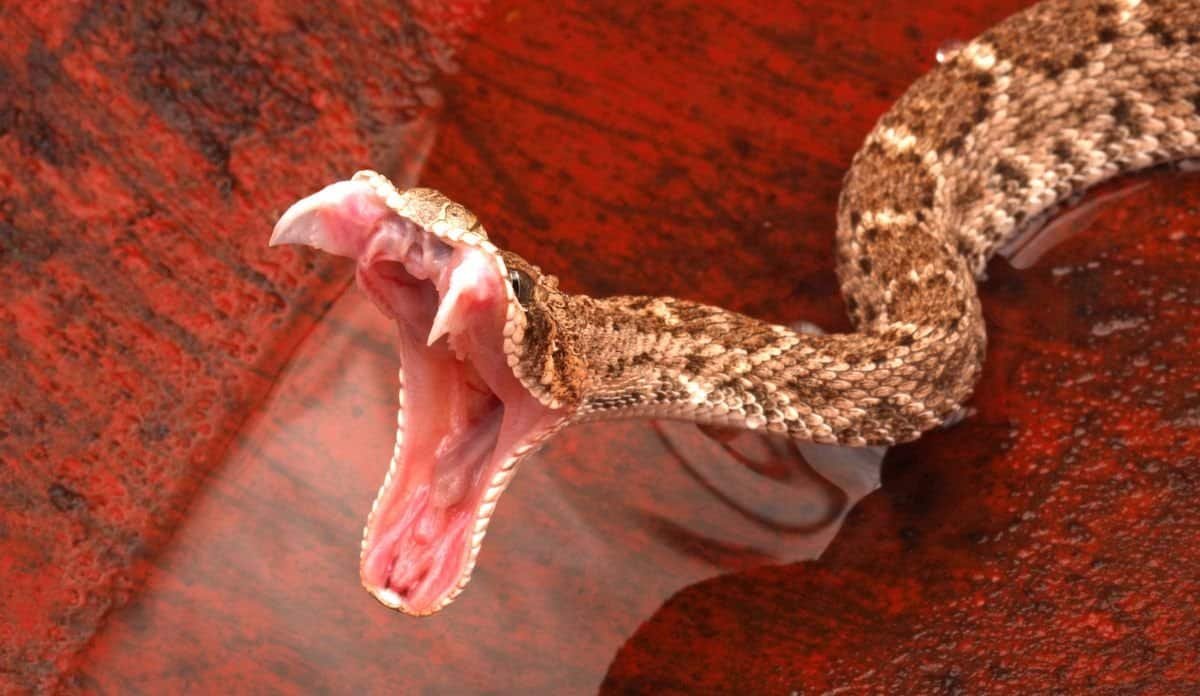
The western diamondback rattlesnake is one of North America’s most recognizable and widespread venomous snakes, found from California and Oklahoma down into northern Mexico. Its bold diamond-shaped patterns and signature rattle make it a symbol of the American desert.
This rattlesnake’s fangs can reach up to 1.5 centimeters (about 0.6 inches) in length. Like other pit vipers, the western diamondback’s fangs are solenoglyphous—folding back against the roof of the mouth and swinging forward for a lightning-fast strike.
When threatened or hunting, the western diamondback uses its long, hollow fangs to inject potent hemotoxic venom deep into its prey. The venom works by destroying blood cells and tissue, quickly immobilizing small mammals, birds, and reptiles. The curved, needle-like fangs ensure the venom reaches vital areas, making each bite highly effective.
While its fangs aren’t the longest among rattlesnakes, they are perfectly suited for penetrating fur and tough hides—an advantage when hunting desert rodents and rabbits. The snake’s rattle serves as a warning, but if ignored, its fangs can deliver a serious bite that requires prompt medical attention.
The western diamondback rattlesnake’s combination of long, retractable fangs and powerful venom makes it a formidable predator and a creature to respect in the wilds of the American Southwest.
9. King Cobra
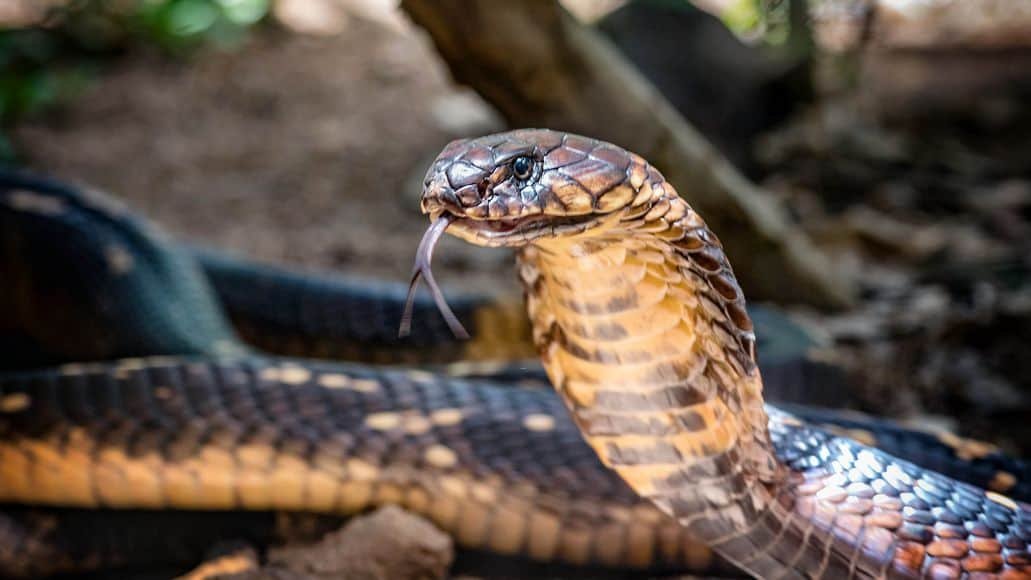
The king cobra has some of the most impressive fangs around. These deadly weapons measure almost half an inch long, which is substantial for a venomous snake, but smaller than you’d expect for a snake as large as this one.
The reason for that is that the king cobra’s fangs stay fixed to its upper jaw. They don’t retract. This means that if they were longer, they’d pierce right through the snake’s mouth.
The fangs angle backward, helping push prey toward the stomach after a bite.
When the king cobra strikes, its fangs deliver a hefty dose of venom loaded with powerful neurotoxins that attack the nervous system. The venom isn’t the most potent among all snakes, but the king cobra makes up for it with sheer volume. A single bite can deliver enough venom to cause respiratory failure.
The fangs fit the king cobra’s hunting style perfectly. As the world’s longest venomous snake, it uses these weapons to take down other snakes and large prey across Southeast Asia.
10. Black Mamba
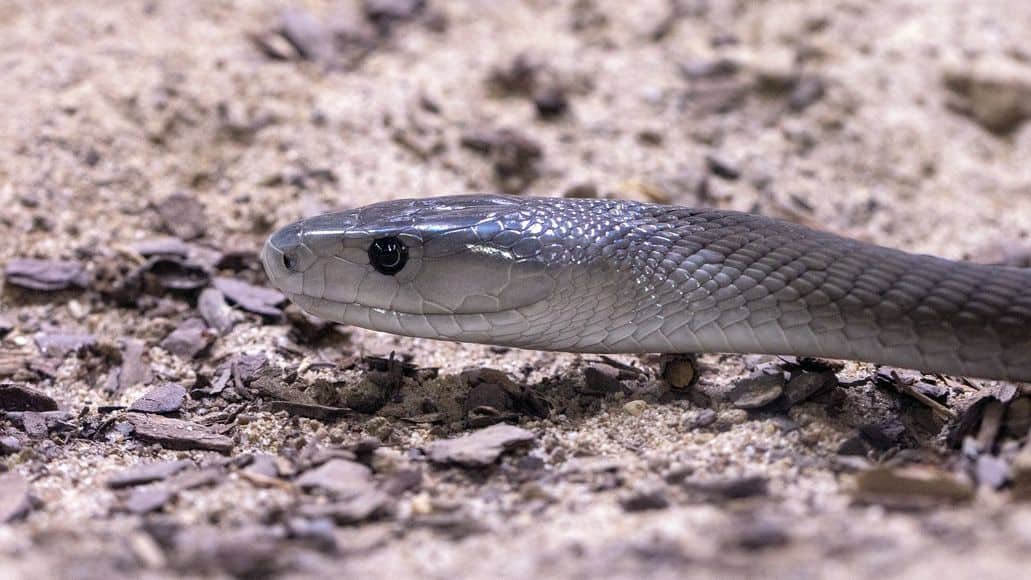
The black mamba has the longest fangs of any elapid snake. These fangs measure around 5 to 6 mm (0.2 to 0.24 inches) on average. They are fairly small relative to the size of the snake, but they are perfect for delivering venom quickly.
You’ll find these snakes in sub-Saharan Africa. They’re not actually black outside—the name comes from the inky color inside their mouth.
The fangs work like tiny needles, injecting deadly venom. The black mamba’s venom acts fast, attacking your nervous system almost immediately.
If you were bitten, symptoms could start within 10 minutes. The venom blocks nerve signals throughout your body.
The snake’s long fangs help it deliver more venom deeper into tissue. The fangs fold back when not in use, then swing forward during a bite.
Sharp, long fangs and fast-acting venom make the black mamba one of the world’s most dangerous snakes. Its venom can cause paralysis and breathing problems in no time.
11. Inland Taipan
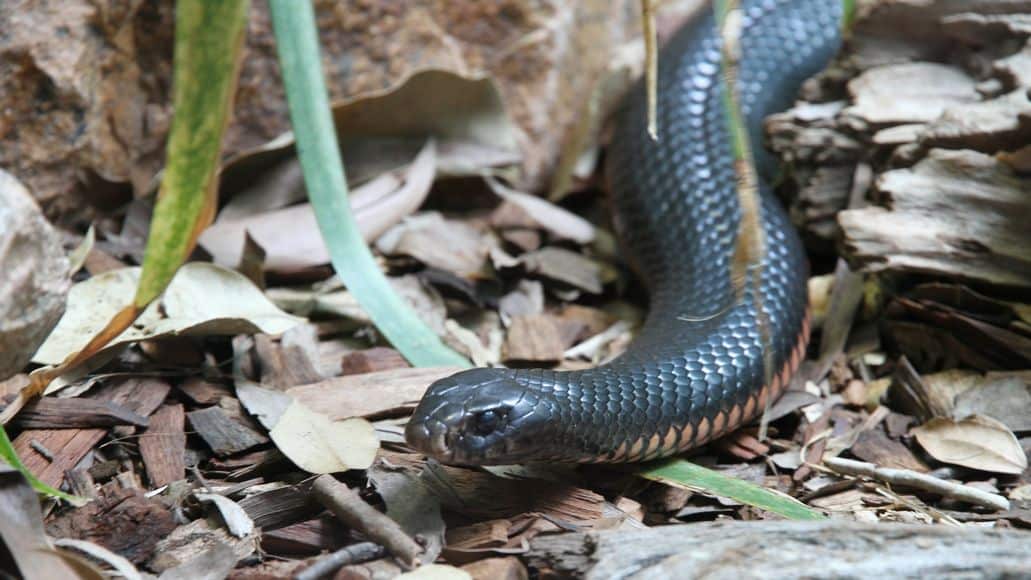
The inland taipan, also known as the “fierce snake” or “small-scaled snake,” is native to the arid regions of central Australia. Despite its unassuming appearance, this snake holds the title of the world’s most venomous snake, with venom strong enough to kill 100 men in a single bite.
The inland taipan’s fangs are relatively short compared to some vipers, measuring up to 3.5–4 mm (about 0.15 inches), but they are perfectly adapted for rapid, repeated strikes. The fangs are fixed at the front of the mouth (proteroglyphous), allowing the snake to deliver venom quickly and efficiently with minimal movement.
When hunting, the inland taipan can deliver multiple precise bites in rapid succession, each time injecting a lethal dose of neurotoxic venom that acts swiftly on the victim’s nervous system. This venom also contains myotoxins and procoagulants, making it especially deadly to small mammals, which are its primary prey.
Despite its reputation, the inland taipan is extremely shy and rarely encountered in the wild. It prefers to avoid confrontation, relying on its speed and reclusive habits rather than aggression. Bites to humans are exceedingly rare, but any encounter with this snake should be treated with the utmost caution due to the potency of its venom.
The inland taipan’s combination of efficient fangs and unmatched venom potency makes it a legendary predator of the Australian outback—deadly, elusive, and fascinating.
How Snake Fangs Work
Snake fangs act like hollow needles, injecting venom deep into prey. The length and design of these fangs help snakes kill and start digesting their victims before swallowing.
Purpose Of Long Fangs
Long fangs give snakes some serious advantages when they’re hunting. These fangs can penetrate deep into their prey’s body, hitting vital organs and blood vessels that a shorter tooth just couldn’t reach.
When you spot a snake with those impressive long fangs, you’re seeing nature’s take on a precision hunting tool. The extra length lets venom get to the places where it does the most damage, and does it fast.
Long fangs also help snakes go after bigger meals. A mouse, for example, has thick fur and skin—a real challenge for short fangs. But longer fangs? They just punch right through.
The Gaboon viper is a wild example, with fangs that can reach up to 2 inches. That lets it take down bigger animals than snakes with shorter fangs. Those fangs can dig right through thick skin and muscle, no problem.
Ambush hunters really benefit here, too. These snakes hang out, wait for something tasty to wander close, and then strike in a flash. Long fangs help them grab and hold on while pumping in venom.
Venom Delivery Mechanisms
Snake fangs act like tiny syringes for venom. Each fang has a hollow center or a groove that carries venom from special glands in the snake’s head all the way down to the tip.
When a snake bites, muscles squeeze the venom glands and push venom through little tubes that run into the fangs. The venom travels down the fang and right into the prey.
Different snakes have different fang setups:
- Solenoglyphous fangs fold back when not in use
- Proteroglyphous fangs stay fixed in place
- Opisthoglyphous fangs sit in the back of the mouth
Vipers like the Gaboon viper have solenoglyphous fangs, which can swing forward when it’s time to strike. It’s kind of like a switchblade flipping out for each bite.
The Gaboon viper can inject as much as 2,400 milligrams of venom in one bite. Instead of biting and letting go, it holds on, pumping even more venom into its victim.
Adaptations For Hunting With Long Fangs
Long fangs give snakes a serious edge when they’re out hunting. These teeth work hand-in-hand with special hunting styles and careful placement to make each strike count.
Prey Capture Strategies
Snakes with long fangs hunt differently than those with short ones. The Gaboon viper, with its massive fangs, is a prime example.
- Strike and Wait Method A lot of long-fanged vipers go for a “hit-and-wait” approach. They strike quick, inject venom deep, and then just back off to let the venom do its work. This strategy keeps the snake out of harm’s way. Big prey can fight back, and that’s risky. By waiting, the snake avoids a dangerous struggle.
- Ambush Hunting Long fangs really shine for ambush predators. These snakes stay hidden until something walks by, then explode out with a fast, hard strike. Long fangs punch right through fur and thick skin, so the venom gets where it needs to go. Shorter fangs just can’t reach as deep.
- Quick Strikes Vipers with long fangs are built for speed. Their fangs fold back when not in use, letting them open their mouths wider and strike faster.
Fang Placement and Structure
The way long fangs are built and arranged in a snake’s mouth makes them perfect for hunting. Every part has a job.
- Hinged Design Long fangs act like switchblades. When not needed, they fold back against the roof of the mouth, staying sharp and out of the way. When it’s time to strike, muscles snap the fangs forward in less than a second. They lock into place, ready for the bite.
- Hollow Structure Long fangs are basically tiny needles, hollow inside and connected to venom glands. This setup lets venom flow straight into the prey. The longer the fang, the deeper the venom goes. That means it spreads through the prey’s body much faster.
- Front Placement Long fangs sit right at the front of the mouth, giving the snake better aim and control during a strike. The bite lands exactly where it needs to. This front placement works with the snake’s head shape, too. When the mouth opens wide, the fangs angle forward and down, making it easier to pierce prey.
Longest-Fanged Snakes: Conclusion
The Gaboon viper really takes the crown when it comes to fang length. Its two-inch fangs are unmatched among venomous snakes—seriously, nothing else comes close.
We’ve just looked at eleven snakes with some pretty wild fangs. Every one of them has evolved those teeth to fit their own way of hunting. Nature’s got a knack for variety, doesn’t it?
Key takeaways from this exploration:
- Only 600 out of 4,000 snake species are venomous
- Fang length varies greatly between species
- Larger snakes often have longer fangs
Snake fangs come in all shapes and sizes, showing just how creative evolution can get. Whether it’s the massive Gaboon or smaller, sneakier species, each snake seems to have landed on just the right tool for the job.
Honestly, learning about these creatures makes you appreciate their design—even if you’d prefer to admire them from afar. Those fangs? They’re the result of countless generations adapting and surviving. Impressive, a little terrifying, and totally fascinating.
Leave a Reply